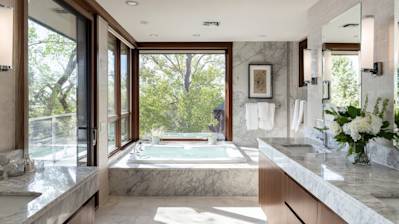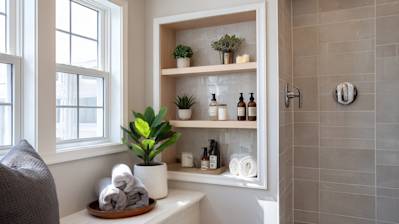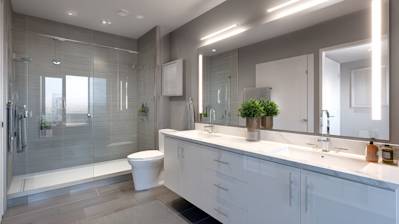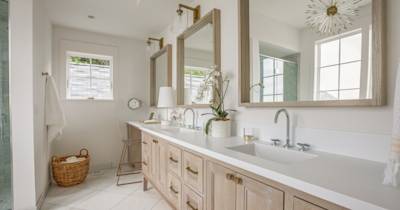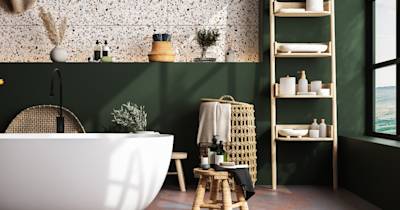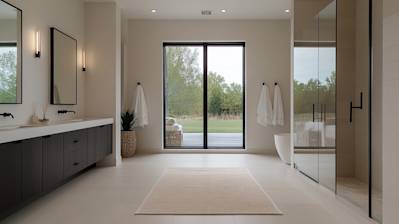As bathroom designs continue to evolve with modern aesthetics and functionality, the popularity of walk-in showers has skyrocketed. Leaving behind the conventional, old-fashioned tub and shower combos, homeowners now lean towards walk-in showers due to their sleek look, open design, and ideal space utilization.
So, if you're contemplating a bathroom remodel or designing a new one, you might want to consider the beauty and versatility of walk-in showers.
Understanding Walk-In Showers: What They Bring to Your Bathroom
Simply put, walk-in showers are showers that require no stepping over any threshold or edges. They present a simplistic, barrier-free design that seamlessly blends with modern and contemporary bathroom décors.
Minimalistic Modern Design
Walk-in showers feature a minimalistic design that tends to maximize space while offering a clean, streamlined appeal. The reductive design eliminates any unnecessary components, leaving a shower space that's easy to navigate.
Seamless Integration
Walk-in showers can be custom-built to fit any bathroom size. Whether your bathroom space is large or small, a walk-in shower has the capability to be seamlessly integrated, providing you with a stylized and modern bathroom.
Various Design Options
From frameless glass enclosures and tiled versions to doorless and curved styles, walk-in showers diversely range in designs. You can customize their look based on your preferred style and the existing bathroom décor, making them highly versatile.
Characteristics of Walk-In Showers
Distinct features make walk-in showers an excellent addition to your bathroom:
- No physical barrier: They are easily accessible without the need to step over any barrier, promoting a smooth transition from the bathroom to the shower area.
- Shower doors: Most homeowners prefer glass doors that provide an open, airy feel. However, some choose to go for doorless designs.
- Materials: Various construction materials are used, like tiles, glass, marble, granite, etc., without any limitations.
Walk-In Showers: The Stalwart of Accessibility
One of the prime advantages of walk-in showers is the augment of accessibility they bring to your home, particularly for the elderly and physically challenged. Their barrier-free design, along with the possibility of including accessibility fixtures like grip bars and non-slip floors, makes them a sensible choice for any household.
Customizing Your Walk-in Shower: Features to Consider
Designing your perfect walk-in shower needs consideration of a few vital features:
- Showerheads: From rainfall to handheld, multiple showerhead options can be incorporated based on your preference.
- Shower seats: Especially for larger walk-in showers, a built-in or folding seat can be beneficial for those who wish to sit while showering.
- Storage: Multiple options for storing bath items such as inbuilt niches or hanging caddies can be included.
- Lighting: Suitable lighting can invariably enhance the shower experience and provide a relaxing ambiance.
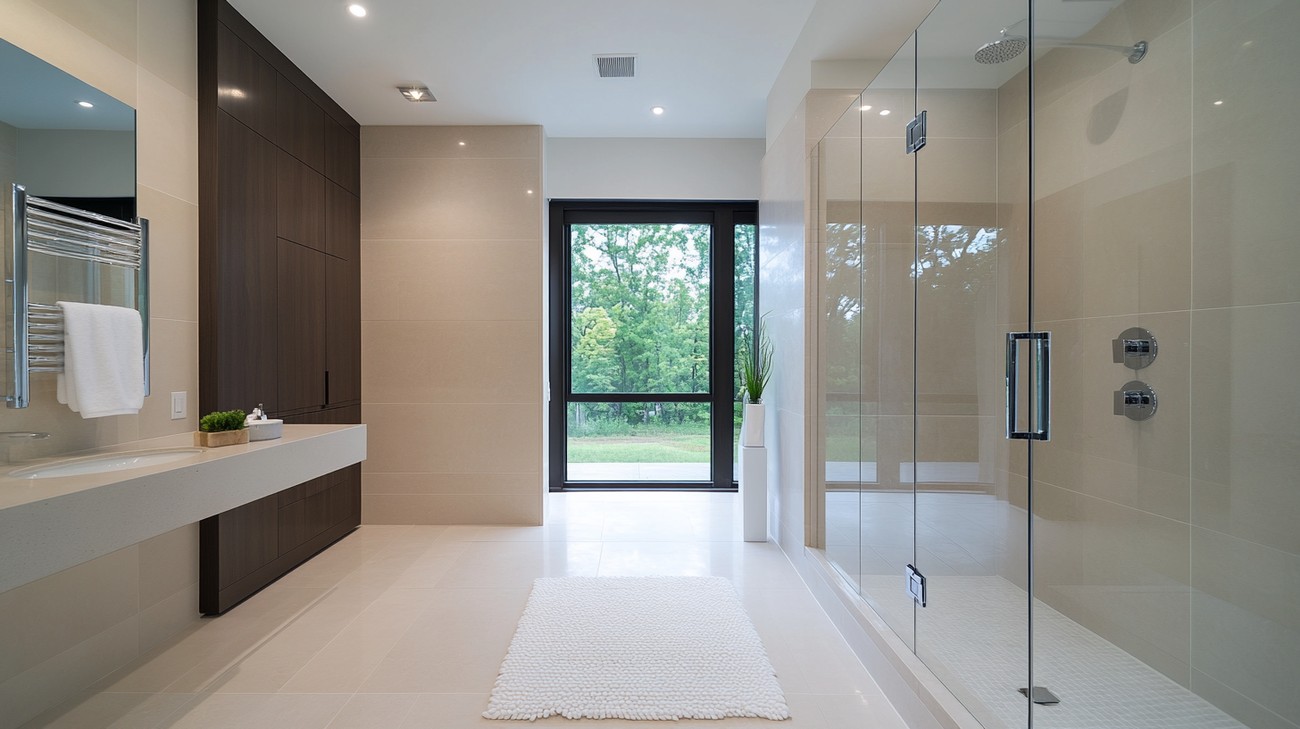
Frequently Asked Questions about Walk In Shower
How is a Walk-In Shower Different from a Traditional Shower?
The main difference between a walk-in shower and a traditional shower lies in the accessibility and design. Walk-in showers have an open design that often doesn’t require a door. They have a smooth transition from the bathroom floor to the shower, making them safer and easier, especially for people with mobility challenges. Traditional showers typically include a tub and curtain or enclosed glass doors.
How Much Space is Needed for a Walk-In Shower?
The amount of space needed for a walk-in shower can vary based on your desired layout. However, the minimum space required by most building codes for a walk-in shower is 30 inches by 30 inches. If you want a more spacious shower area, you may choose to have a bigger walk-in shower depending on your bathroom's overall size.
How Long Does Installation of a Walk-In Shower Take?
The timeline for walk-in shower installation can highly vary, often based on the complexity of the project and the existing bathroom conditions. Generally, it could take anywhere between 1-3 weeks. It involves several steps, from the removal of the old tub or shower, plumbing adjustment, addition of new tiles and installation of shower fixtures.
What Materials are Most Commonly Used in a Walk-In Shower?
Walk-in showers can incorporate a variety of materials, depending on the desired design and style. Common materials include porcelain, ceramic and glass tiles due to their durability, water-resistance, and aesthetic appeal. Other materials such as natural stone, acrylic, and tempered glass can also be used.
How to Ensure Water Doesn't Get Out of a Walk-In Shower?
Although walk-in showers have open designs, there are several ways to prevent water from escaping the shower area. This can be accomplished by using water shields or splash guards, implementing a proper floor gradient for good water drainage, incorporating half-walls or panels, or installing shower screens.
Are Walk-In Showers Easy to Clean?
Yes, walk-in showers are often easier to clean compared to traditional tub-and-shower setups. They tend to have fewer hard-to-reach areas and fewer crevices where soap and mildew can build up. However, the cleaning ease could depend on the materials used for tiles and the style of shower fixtures.
Can a Walk-In Shower Increase Home Value?
Adding a well-designed, quality walk-in shower to your home can potentially increase its value. Many homebuyers today prefer modern and accessible designs, which a walk-in shower provides. However, it's advisable to consider market trends and buyer preferences in your specific area.
Is a Walk-In Shower Suitable for a Small Bathroom?
Absolutely, a walk-in shower can be a great addition to a small bathroom. Walk-in showers work well in compact spaces due to their open feel and design which features no doors or curtains, creating an illusion of a bigger space.
Can a Walk-In Shower Be Installed in An Existing Bathroom?
Yes, a walk-in shower can be fitted in an existing bathroom as long as there is sufficient space to accommodate it. It usually involves the removal of the existing tub or shower and an adjustment of the plumbing fixtures.
What Types of Shower Heads Can Be Used in a Walk-In Shower?
Virtually any type of shower head can be used in a walk-in shower - handheld showerheads, rainfall showerheads, and body sprayers are all popular choices. The selection highly depends on your personal preferences, design aesthetic, and specific needs.

Pros of Walk-In Showers
Accessible
Walk-in showers offer an easy entrance and exit compared to traditional bathtubs, making them a great choice for the elderly, disabled, or anyone with mobility issues. No longer do you have to step over a high tub wall, which can be quite cumbersome and potentially dangerous.
Aesthetically Pleasing
Walk-in showers often make a better visual statement as compared to traditional showers. The purity in the design forms a modern, minimalistic oasis in the bathroom. This comes from the option for custom design, tile choices and inclusion of shower panels, creating a spa-like experience at home.
Easy to Clean
Walk-in showers are easier to clean because their open design eliminates areas where grime and mildew can hide. Besides, showers made from tile and glass are less likely to develop soap scum and hard water stains. Since there's no bathtub ring or other hard-to-reach areas, cleaning can be more efficient.
Space-Efficient
A walk-in shower takes up less room than a traditional bathtub-shower combo, so it can be a great option if you have a small bathroom. They also create a sense of space, thanks to their open design.
Energy Efficient
Walk-in showers are typically smaller than standard tubs, meaning they require less water to fill. Additionally, because you're only using water when it's required, they can also help save on energy costs as less heat is wasted whilst the shower is running.
Cons of Walk-In Showers
Cost
Installing a walk-in shower could be slightly more expensive compared to a traditional bathtub. You'll also need to consider the cost of sealing the shower surround, tiles, and also the expense of installing glass doors if preferred.
Not Suitable for Bath Lovers
If you love relaxing in a warm bath at the end of a hard day, a walk-in shower won't provide that option. You could install a separate tub, but that takes up more space and increases costs.
Resale Factor
While walk-in showers are stylish and trendy, not having a bathtub in at least one bathroom could potentially turn off certain buyers when it's time to sell your home. Families with small children often prefer bathtubs, so it's important to consider this factor if resale value is a concern.
Water Leakage
Although walk-in showers are designed to contain water effectively, they can be prone to leaks if not properly installed or built. The absence of a threshold means water can potentially escape more easily than in a traditional enclosed shower or bathtub.
Decreased Privacy
Walk-in showers often come with clear or semi-clear glass doors or even no doors at all, which might not appeal to everyone. If you're accustomed to the privacy provided by a shower curtain or solid door, you may find a walk-in shower too exposed.
Temperature Control
Without the enclosure of a traditional bath or shower, the exposure of a walk-in design could make you feel chilly at times. This might not be a big deal in warmer climates, but it could get uncomfortable during colder months.
Longer Installation Time
Installing a walk-in shower usually takes longer than fitting a traditional bathtub. This is particularly true if you're converting from a tub to a walk-in shower, which often requires a complete remodel of your bathroom.

Myths and Misconceptions about Walk-in Showers
Myth 1: Walk-in Showers Are Only for the Elderly or Disabled
The Origins of the Myth
This misconception likely stems from the fact that walk-in showers are often featured in home designs and remodels aimed at accommodating individuals with mobility issues.
The Reality
While walk-in showers can greatly enhance accessibility, they are not exclusively for the elderly or disabled. In fact, many design-conscious homeowners choose walk-in showers for their sleek, modern aesthetics and easy-to-clean nature. Regardless of age or physical ability, anyone can enjoy the convenience and style of a walk-in shower.
Myth 2: Walk-in Showers Take Up More Space
The Origins of the Myth
This misconception probably originates from the association of walk-in showers with luxury bathrooms, which are often spacious.
The Reality
Walk-in showers can be designed to fit a variety of spaces, small or large. By removing the bathtub or shower-bath combination, a walk-in shower can even free up space in smaller bathrooms. With careful planning and correct installation, a walk-in shower can actually make a compact bathroom appear more spacious and less cluttered.
Myth 3: Walk-in Showers Are More Expensive to Install
The Origins of the Myth
This belief likely comes from the perception that walk-in showers are upscale bathroom features.
The Reality
While walk-in showers can be more expensive due to the potentially higher cost of materials like frameless glass and custom tile, the installation cost can also be lower in some cases. For instance, removing an old tub or damaged tile can involve extra labor and costs not necessarily needed when installing a walk-in shower. Moreover, the overall cost can vary greatly based on the design, size, and specific features of the walk-in shower.
Myth 4: Walk-in Showers Cause More Water Splashes
The Origins of the Myth
This myth may stem from the open design of many walk-in showers.
The Reality
While this may sometimes be true, it largely depends on the design of the shower. Many walk-in showers feature glass enclosure or half-walls to contain water splashes. Properly positioned showerheads and appropriately sloped floors also help keep water contained.
Myth 5: Walk-in Showers Reduce a Home's Resale Value
The Origins of the Myth
The belief could stem from the idea that home buyers prefer traditional bathtub-shower combinations.
The Reality
Changing housing trends show a growing preference for large, sleek, walk-in showers. Additionally, a well-designed and modern walk-in shower can be a selling point for potential buyers, thereby boosting the home's resale value. Nevertheless, the impact on resale value may depend on the buyer's preferences, lifestyle, and the overall housing market and trends in your area.
Myth 6: Walk-in Showers Are Not Kid-Friendly
The Origins of the Myth
This misconception may come from the lack of a bathtub which is often used for bathing children.
The Reality
While bathtubs can make bathing younger children easier, older children can also use walk-in showers independently. Additionally, it is also possible to use a removable baby tub during the early years. Plus, walk-in showers can be designed with safety features such as non-slip tiles and grab bars.
Remember, it is crucial to do your own research and consult with a professional when considering adding a walk-in shower to your home. This will help you make a more informed decision and dispel any myths that might be steering you away from an option that could potentially be perfect for your bathroom.
Summary
Having a walk in shower can add both functionality and style to your bathroom. It can serve as a practical option for those who have mobility issues as well as enhance the overall aesthetic appeal of your bathroom. Not to mention the added value it brings to your home as modern homeowners are leaning towards this bathroom feature.
A major selling point of a walk in shower is its easy accessibility and lower maintenance compared to traditional tubs. Bathrooms with tubs require a great deal of effort to clean and maintain, whereas a walk in shower doesn't. Additionally, the lack of physical barriers promotes a seamless flow, creating the illusion of a larger bathroom space.
Lastly, the options for customizing a walk in shower are endless. You can choose from various designs, sizes, and materials to create a shower space that suits your personal style and needs. Whether you prefer a minimalist, country, or modern style, a walk in shower can accommodate your preferences while ensuring practicality and comfort.
About New Day Construction
New Day Construction is a Kirkland, WA based construction company committed to building beautiful homes and creating dream spaces with impeccable attention to detail. With a well-earned reputation for quality work and reliability, we are proud to serve the Kirkland community and the broader Washington state. From thorough site inspections, planning and designing to construction and post-build services, New Day Construction ensures a seamless experience. Whether we're creating a new build, an addition, or redesigning an existing space, you can rely on our expert team to deliver top-notch workmanship on every project. We believe in transparency, sticking to timelines, efficient communication, and making your dream home a reality.



